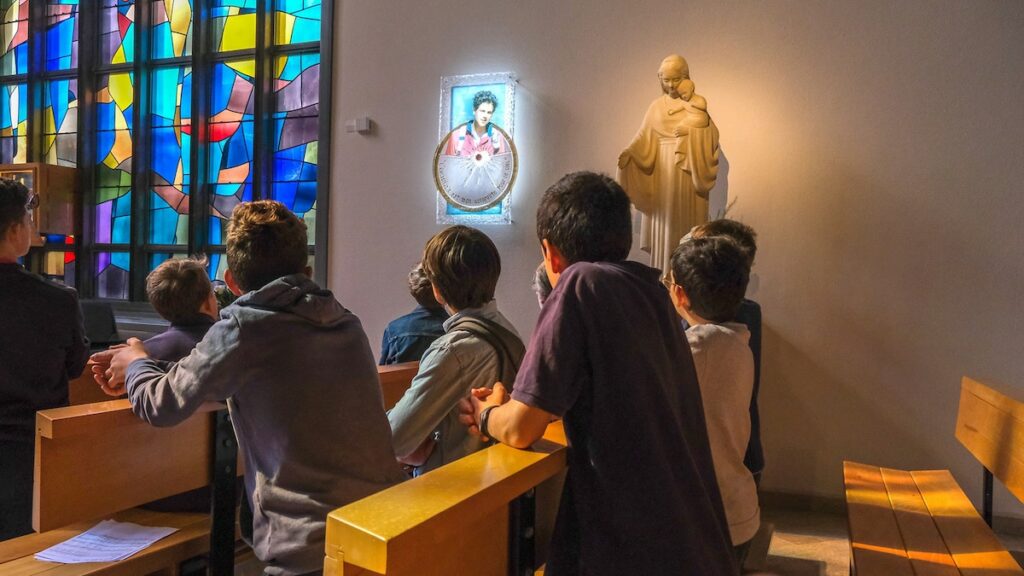He’s been called God’s influencer. The patron saint of the internet. And now Carlo Acutis will be the first-ever millennial to be named a saint by the Roman Catholic Church.
On July 1, the Vatican approved the canonization of the teenage tech whiz who died of leukemia in 2006.
Much has been made of the announcement, which turns the traditional image of a saint on its head. Acutis isn’t an ancient biblical figure or a religious martyr from the Crusades. He designed a website to catalog miracles. In other words, he’s a modern saint.
“Canonization is fundamentally about holiness—but it’s also about relevance,” says Kathleen Sprows Cummings, history professor at the University of Notre Dame and author of the book A Saint of Our Own.
As young people leave the Catholic Church in droves, there’s perhaps no one more relevant than the first millennial saint. “He’s a saint that they could see themselves reflected in,” Cummings says. “That’s really the whole point of saints.”
But what does it take to become a saint in the modern era? Here’s how the centuries-old practice is staying relevant.
Who gets to be a saint?
In the Catholic Church, sainthood is an official confirmation that a person has entered God’s eternal presence—basically, that they made it to heaven by living “heroically virtuous lives.”
Saints are no different from anyone else in heaven. The title simply changes how they’re venerated on Earth: The Church can erect shrines to them or designate days in their honor, for example.
But not everyone who lived a heroically virtuous life will be formally declared a saint. That’s because the process is arduous—and strategic.
Anyone can open a petition for a saint, but they must first convince their bishop that the cause is worthy. A candidate for sainthood also has to have been dead for at least five years, although the Pope can make exceptions.
(Here’s how Mother Teresa’s canonization was fast-tracked.)
Once a cause is open, local investigators comb through their writings and interview everyone who knew them to prove their virtues, including faith, hope, charity, justice, and courage. If these virtues are demonstrated—and the Pope affirms it—a person is declared “venerable.”
That’s when the miracles come in. The Catholic Church requires evidence of one miracle to beatify a prospective saint—which then allows the local church to venerate a person, a practice of bestowing them with special honors. After a second miracle occurs at this stage, the church can officially canonize them.
What counts as a miracle in an age of science?
In the 20th century, 99 percent of miracles have been medical, writes physician and historian Jacalyn Duffin. That’s because they’re a little more straightforward to argue than, say, the spontaneous multiplication of loaves and fishes.
To prove a miraculous healing, the Vatican convenes a committee of doctors to evaluate a patient’s medical records and testify that there wasn’t a scientific explanation for a cure.
(In Venezuela, a quest for sainthood offers proof of miracles.)
The harder thing to prove is that healing could have only occurred through divine intervention. Cummings says the Church is more likely to declare a miracle if an injury was beyond hope and healed quickly. For the prospective saint to get credit for it, devotees must swear that they’d prayed only to him or her and no one else.
But even these miracles are getting increasingly complicated with modern medicine, Cumming says. In fact, the requirement for sainthood used to be four miracles before reforms under Pope John Paul II cut that number in half in 1983.
What makes a saint relevant?
Sainthood is a rare honor in part because it can be so difficult for a case to wind its way through the Vatican’s bureaucracy. (For example, the Vatican has rejected miracles for errors in the paperwork.) But it also has to do with who you know—and how you can help the church remain relevant.
Saint-making plays a big role in energizing Catholic membership. Harvard University researchers Robert Barro and Rachel McCleary demonstrated as much in their 2016 analysis of all the beatifications and canonizations from 1590 to 2009. As a region’s Protestant population grew, they found that so too did its number of Catholic saints.
(Meet Sara-la-Kali, the unofficial patron saint of displaced people.)
“Since around 1900, the naming of blessed persons seems to reflect a response by the Catholic Church to competition from Protestantism or Evangelicalism,” they wrote.
So is the canonization of Acutis likewise a strategic play to lure millennials back into the Catholic Church?
“Of course it is,” says Cummings. She argues that this doesn’t diminish his holiness—but it only makes sense now, as the age gap in religion grows across the world. Even more telling, she adds, is that the Vatican seems poised to formalize the decision during its 2025 Jubilee, an important time of pilgrimage.
“Just imagine all the young people that are going to come to this canonization,” Cummings says. “It’ll send a powerful message.”
>>> Read full article>>>
Copyright for syndicated content belongs to the linked Source : National Geographic – https://www.nationalgeographic.com/culture/article/modern-saint-catholic-church
